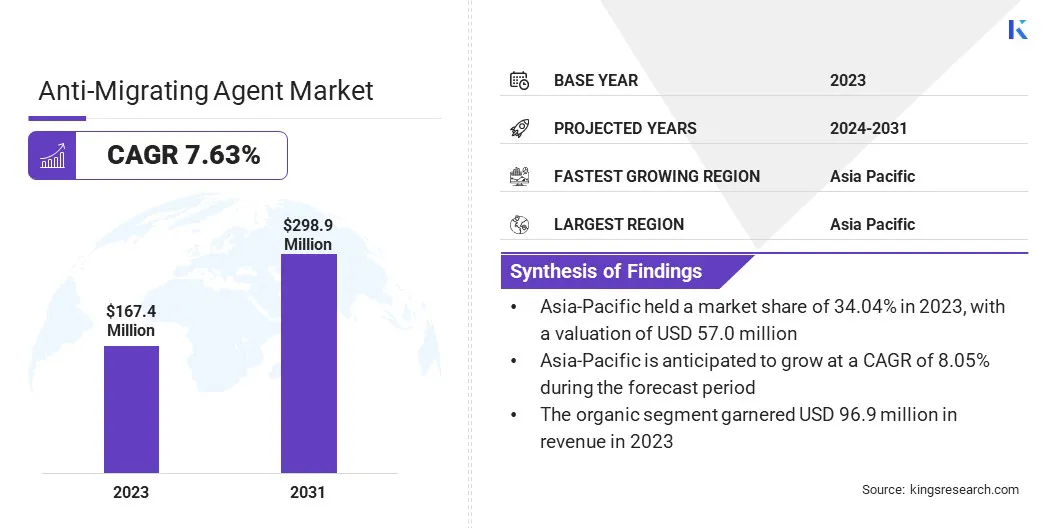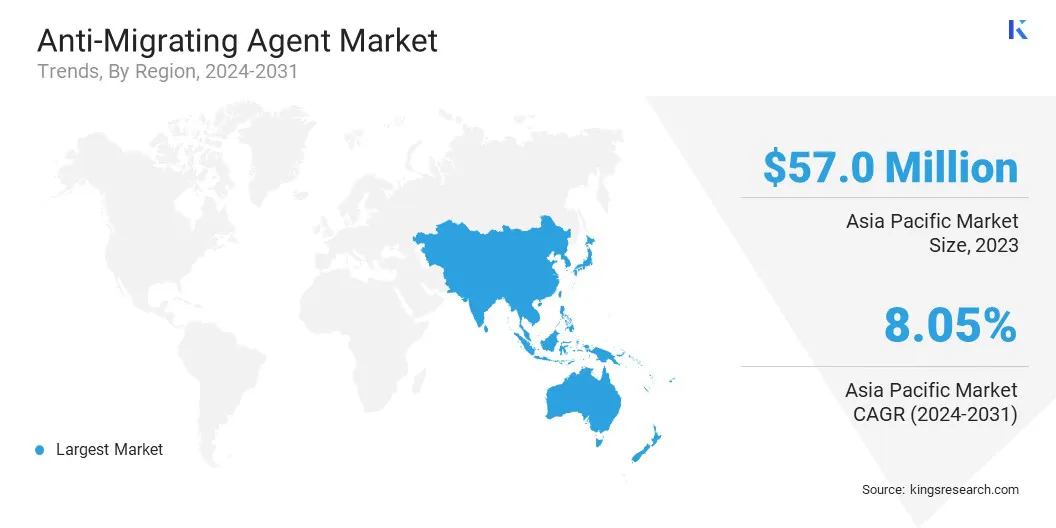Market Definition
The market involves the production and supply of chemical additives designed to prevent the migration of various substances, such as plasticizers, stabilizers, or other additives, from one part of a material to another.
These agents are primarily used in polymers and plastic products to improve their durability, stability, and performance over time.
Anti-migrating Agent Market Overview
The global anti-migrating agent market size was valued at USD 167.4 million in 2023 and is projected to grow from USD 178.6 million in 2024 to USD 298.9 million by 2031, exhibiting a CAGR of 7.63% during the forecast period.
This growth is primarily driven by the increasing demand for high-quality, durable materials across various industries such as packaging, automotive, electronics, and healthcare. Anti-migrating agents are crucial in ensuring the stability and longevity of polymers and plastic products by preventing the migration of additives which can compromise product performance and safety.
Key Market Highlights
- The anti-migrating agent industry size was valued at USD 167.4 million in 2023.
- The market is projected to grow at a CAGR of 7.63% from 2024 to 2031.
- North America held a market share of 34.04% in 2023, with a valuation of USD 57.0 million.
- The anionic segment garnered USD 53.4 million in revenue in 2023.
- The food segment is expected to reach USD 114.8 million by 2031.
- The inorganic segment is anticipated to register the fastest CAGR of 7.65% during the forecast period.
- The natural segment garnered USD 87.7 million in revenue in 2023.
- The dyeing segment is expected to reach USD 101.5 million by 2031.
- The market in Asia Pacific is anticipated to grow at a CAGR of 8.05% during the forecast period.
Major companies operating in the anti-migrating agent market are SNF, artience Co., Ltd., Tanatex Chemicals B.V., Shree BS Chemicals, Hangzhou Chungyo Chemicals Co., Ltd., RUDOLF Holding SE & Co. KG, Weifang Ruiguang Chemical Co. Ltd., BEN TECH CHEMICAL, Dymatic Chemicals, Inc., N S CHEMICALS & CONSULTANTS PVT. LTD., BASF, Evonik Industries AG, Asutex, Arkema, and Sarex.

Rising consumer awareness of product quality and safety, along with the expanding need for sustainable and long-lasting materials, is further contributing to the market's growth. Innovations in material science and stricter regulatory standards for product safety & quality are expected to fuel the demand for anti-migrating agents, positioning them as essential components in the manufacturing of advanced high-performance materials.
- In August 2024, Tanatex Chemical entered into a strategic alliance with Werken to enhance its capabilities and expand its market presence. This partnership allows Tanatex to leverage Werken's expertise in advanced chemical solutions and innovation, specifically in the field of textile and material processing.
Industries such as packaging, automotive, electronics, healthcare, and construction require materials that offer enhanced durability, safety, and functionality. This increases the need for high-performance materials that withstand harsh conditions and have longer lifespans while maintaining their integrity and safety.
Anti-migrating agents prevent the migration of additives, ensuring material stability and product safety. In packaging, these agents prevent harmful chemicals from leaching into food, while in electronics and healthcare, they maintain the performance and safety of components and devices.
The shift toward sustainable practices are driving the demand for eco-friendly anti-migrating agents that meet both performance and environmental goals, further fueling the market.
- In January 2025, Pilot Chemical Company announced plans to significantly expand its anionic surfactant production capacity to meet growing demand across various industries, including personal care, cleaning, and industrial applications.
Regulatory Compliance and Standards
Regulatory compliance is a major challenge for the anti-migrating agent market, as different regions have varying and strict regulations on chemical use in products. In sectors like food packaging, healthcare, and pharmaceuticals, anti-migrating agents must meet safety standards set by regulatory bodies like the FDA and the EU's REACH.
These regulations ensure that harmful chemicals do not migrate into consumables or medical products. Manufacturers must invest significant resources to ensure compliance, and frequent updates to safety standards add complexity and cost. Navigating these diverse regulations can create barriers for companies expanding into new markets.
Collaborating with regulatory experts and third-party testing organizations can help ensure that products meet the necessary safety and quality requirements. Investing in research and development to create versatile, compliant formulations that can be used across multiple markets can streamline the process.
Manufacturers can also maintain a robust documentation and reporting system to quickly address regulatory inquiries and provide transparency. By prioritizing compliance from the early stages of product development and fostering strong relationships with regulatory bodies, companies can reduce the risk of non-compliance, minimize delays, and navigate diverse regulatory landscapes more effectively.
Shift Toward Sustainable, Bio-based, and Eco-friendly Solutions
Focus on sustainable, bio-based, and eco-friendly solutions is growing in the anti-migrating agent market. Manufacturers are developing anti-migrating agents derived from renewable, non-toxic sources as industries face increasing environmental regulations and consumer demand for greener products.
This trend is particularly significant in sectors like food packaging and healthcare with heightened concerns about chemical safety and environmental impact. Companies are investing in research to create sustainable alternatives that maintain high performance while addressing both safety and sustainability concerns, aligning with global environmental goals and regulatory requirements.
- In January 2024, RUDOLF introduced groundbreaking bio-based innovations for its HYDROCOOL technology, a breakthrough moisture management product line. The new durable bio-based products, RUCO-PUR BIO SLB and FERAN BIO ICR, represent a major turning point in textile chemistry, offering unrivalled sustainability, performance and durability.
Anti-migrating Agent Market Report Snapshot
|
Segmentation
|
Details
|
|
By Type
|
Non-ionic , Anionic, Cationic, Amphoteric
|
|
By Grade
|
Technical, Food, Pharmaceutical
|
|
By Chemistry
|
Organic, Inorganic
|
|
By Source
|
Natural, Synthetic
|
|
By Application
|
Dyeing, Textile Printing, Coatings, Others
|
|
By End Use Industry
|
Construction, Automotive, Consumer Goods, Electronics, Healthcare, Others
|
|
By Region
|
North America: U.S., Canada, Mexico
|
|
Europe: France, UK, Spain, Germany, Italy, Russia, Rest of Europe
|
|
Asia-Pacific: China, Japan, India, Australia, ASEAN, South Korea, Rest of Asia-Pacific
|
|
Middle East & Africa: Turkey, UAE, Saudi Arabia, South Africa, Rest of Middle East & Africa
|
|
South America: Brazil, Argentina, Rest of South America
|
Market Segmentation
- By Type (Non-ionic, Anionic, Cationic, Amphoteric): The anionic segment earned USD 53.4 million in 2023, due to its strong compatibility with a wide range of polymers and its effectiveness in preventing the migration of additives in various applications.
- By Grade (Technical, Food, Pharmaceutical): The food segment held 38.43% share of the market in 2023, due to the increasing demand for safe, compliant, and high-quality packaging materials that prevent the migration of additives and ensure food safety.
- By Chemistry (Organic, Inorganic): The organic segment is projected to reach USD 172.8 million by 2031, owing to its versatility, superior compatibility with a variety of polymers, and increasing demand for sustainable, high-performance materials in industries like packaging and healthcare.
- By Source (Natural, Synthetic): The synthetic segment is anticipated to grow at a CAGR of 7.66% during the forecast period, driven by its ability to offer high-performance properties, cost-effectiveness, and scalability in the production of anti-migrating agents for diverse industrial applications.
- By Application (Dyeing, Textile Printing, Coatings, Others): The dyeing segment earned USD 57.6 million in 2023, due to the growing demand for high-quality, durable fabrics and the need for anti-migrating agents to prevent color migration and ensure the longevity of textile products.
- By End Use Industry (Construction, Automotive, Consumer Goods, Electronics, Healthcare, Others): The construction segment is projected to reach USD 81.7 million by 2031, owing to the increasing demand for durable, long-lasting materials and the need for anti-migrating agents to enhance the performance and stability of construction polymers & coatings.
Anti-migrating Agent Market Regional Analysis
Based on region, the global market has been classified into North America, Europe, Asia Pacific, Middle East & Africa, and Latin America.

Asia Pacific accounted for a market share of around 34.04% in 2023, with a valuation of USD 57.0 million. The anti-migrating agent market in Asia Pacific is expected to maintain its dominant position, driven by rapid industrialization, a growing manufacturing base, and increasing demand for high-performance materials across diverse sectors such as automotive, packaging, and healthcare.
The region's expanding consumer goods sector in China, India, and Japan, is also contributing to the growth, as consumers become more concerned about product safety and sustainability. Additionally, the rise in government regulations regarding chemical safety, particularly in food packaging and medical applications, is encouraging the adoption of anti-migrating agents.
The anti-migrating agent industry in Europe is poised for significant growth at a robust CAGR of 7.65% over the forecast period, driven by stringent regulatory frameworks and growing consumer demand for safe, sustainable, and high-quality materials. The European Union's strict regulations on chemical migration, particularly in food packaging and medical products, are pushing manufacturers to adopt anti-migrating agents to ensure compliance with safety standards.
Industries such as automotive, electronics, and healthcare are increasingly relying on advanced polymers and coatings, where anti-migrating agents play a crucial role in maintaining material integrity. The region's focus on sustainability and eco-friendly solutions further boosts the demand for bio-based and non-toxic anti-migrating agents, supporting the overall market growth in Europe.
- In November 2023, Sun Chemical launched new sheetfed offset ink technologies aimed at enhancing printing performance and sustainability. The launch highlights Sun Chemical's commitment to developing sustainable products, addressing the growing need for safer, lower-emission chemicals in the printing and packaging industries.
Regulatory Frameworks
- The Food and Agriculture Organization (FAO), through its Codex Alimentarius Commission, establishes international food safety standards to protect consumer health and facilitate fair trade in food products.
- The European Union (EU), through Regulation (EC) No 1333/2008 on food additives, sets out the conditions under which food additives may be used in foodstuffs, including limits on the migration of chemicals from packaging materials into food.
- The European Union (EU) regulation (Registration, Evaluation, Authorization, and Restriction of Chemicals) REACH (EC) No 1907/2006 governs the registration, evaluation, authorization, and restriction of chemicals.
- The International Organization for Standardization (ISO) established ISO 10993 to address the safety of materials used in medical devices, including the migration of chemicals.
Competitive Landscape
Major companies focus on expanding their portfolios, improving product performance, and ensuring regulatory compliance, while newer entrants offer sustainable and cost-effective solutions.
Strategic partnerships, mergers, and technological innovations are key to gaining market share and staying ahead of competition. This dynamic environment drives continuous innovation and improvement in anti-migrating agent offerings.
- In September 2024, Evonik launched new biosurfactants, TEGO Wet 570 Terra and TEGO Wet 580 Terra, for coatings and inks. The two new products are set to transform the paints, coatings and inks industry by combining high performance with an exceptional sustainability profile.
Key Companies in Anti-migrating Agent Market:
- SNF
- artience Co., Ltd.
- Tanatex Chemicals B.V.
- Shree BS Chemicals
- Hangzhou Chungyo Chemicals Co., Ltd.
- RUDOLF Holding SE & Co. KG
- Weifang Ruiguang Chemical Co. Ltd.
- BEN TECH CHEMICAL
- Dymatic Chemicals, Inc.
- N S CHEMICALS & CONSULTANTS PVT. LTD.
- BASF
- Evonik Industries AG
- Asutex
- Arkema
- Sarex
Recent Developments (New Product Launch)
- In March 2025, Evonik introduced VISIOMER Terra IPGMA, a new low-odor, high-performance methacrylate monomer designed to enhance product quality while supporting sustainability goals. This bio-based monomer is part of Evonik's commitment to green chemistry and reducing environmental impact.
- In February 2025, SABIC launched its new LNP ELCRES CXL polycarbonate (PC) copolymer resins, designed to offer exceptional chemical resistance. These materials aim to assist customers in the mobility, electronics, industrial, and infrastructure sectors in managing increased exposure to harsh chemicals that can lead to environmental stress cracking and premature component failure.


